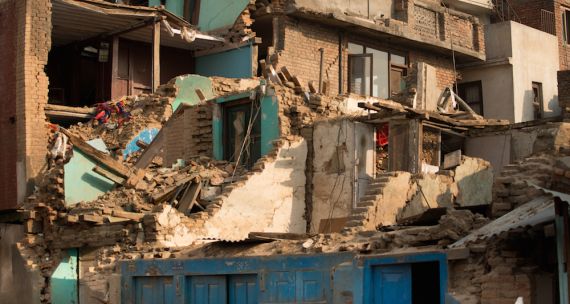China is one of the world's most disaster affected countries [1], but at the same time it has made tremendous advances in the field of information and communication technology (ICT). The Chinese government has an opportunity to harness the innovative potential of smartphones to better weather the natural and industrial hazards facing the country.
Disasters in China
From 2005 to 2015, over 138,000 people were killed in China by earthquakes alone. The magnitude 7.9 earthquake that struck Sichuan province in 2008 killed about 70,000 people, and caused US$60 billion in damages [2]. China is also affected by tropical cyclones, droughts, and floods. Furthermore, with its very rapid economic transition, the country is increasingly exposed to industrial hazards: the largest ever recorded man-made insured loss event in Asia was the massive explosion at the Port of Tianjin in August 2015. This disaster had an estimated property loss that could rise to US$3.5 billion, which would make it the second most expensive property loss in history [3] after the September 11, 2001 attacks in New York.
Mobile phones, the Internet, and social media in China
In parallel to this growing hazard exposure, China has made great strides in developing its telecommunication infrastructure. "Traditional" cellular telephones have already become ubiquitous in most parts of the country. Mobile telephone coverage reaches nearly 100 per cent of the population [1] with a penetration rate of 49 per cent, which corresponds to 765 million unique mobile users [4]. It comes as no surprise then that China Mobile has overtaken Verizon to become the world's largest mobile operator by subscribers.
Expanding beyond the traditional "dumb" cellphone, mobile Internet access via smartphones has been providing online social media in many parts of the country: there are 668 million Internet users in China (about 49% penetration) and 659 million of them active in social media, of which 574 million, or over 87%, are mobile social users [4]. That said, there remains a distinct "digital divide" between the highly industrialized cities on the eastern seaboard, and the rest of the country. This is important because a large portion of the population, about 46 per cent, still lives in rural areas, even if urbanization has been increasing in the last decades [5]. The Chinese government has said it wants to address this divide by expanding broadband Internet coverage across urban and rural areas, with a target of 98 per cent coverage in villages by 2020 [6].
Information and communication technology (ICT) and disasters
There is an array of new risk reduction technologies that Chinese authorities could easily implement because of the country's high-level ICT adoption; if they go ahead and do so, they will be able to significantly reduce the impacts of hazards. Information is essential in times of emergency. Indeed, during the 1995 Kobe earthquake in Japan, communication failures delayed relief efforts for days because outsiders did not receive timely information about the severity of the damage, and this left tens of thousands of homeless survivors in freezing winter weather.
Social media can play a critical role pre-disaster by providing early warning and disseminating instructions amongst an "at risk" population. Furthermore, social media can continue being extremely useful for post-disaster relief by appealing for donations, providing structured two-way communication, and for crowdsourcing data.
Online crowdsourcing has become key during crises, where information and reports are gathered via social media and text messages from mobile phones and plotted into maps in real time by volunteers internationally. This was put into use extensively following the Haiti earthquake in 2010, where emergency responders on the ground were using this geospacial data to determine where and how to direct resources [3]. Similarly, a new mobile application called MyShake [7] is harnessing the accelerometers of individual smartphones to collect real-time data on earth shaking, and providing early warning signals.
Innovative technologies of these types, if integrated into the ICT-friendly Chinese setting, could reduce fatalities by alerting people to take cover, stopping commuter trains, and opening elevator doors.
____________________
ENDNOTES:
[1] United Nations Economic and Social Commission for Asia and the Pacific (UN-ESCAP) (2016). Building e-Resilience in China. Enhancing the Role of Information and Communications Technology for Disaster Risk Management. United Nations publications, Bangkok.
[2] United Nations Economic and Social Commission for Asia and the Pacific (UN-ESCAP) (2015). Disasters Without Borders. Regional Resilience for Sustainable Development. Asia-Pacific Disaster Report 2015. United Nations publications, Bangkok.
[3] Swiss Re (August 2016). Natural catastrophes and man-made disasters in 2015: Asia suffers substantial losses. Sigma No1. Zurich.
[4] Kemp, S. (2015). Digital Statshot China. Key Statistical Indicators for Internet, Mobile, and Social Media Usage in China. http://www.slideshare.net/wearesocialsg/digital-social-mobile-in-china-in-2015 [accessed 24 May 2016].
[5] World Bank (2014). Rural population (% of total population). http://data.worldbank.org/indicator/SP.RUR.TOTL.ZS [accessed 25 May 2016].
[6] International Telecommunications Union (ITU) and United Nations Educational, Scientific and Cultural Organization (UNESCO) (2015).The State of Broadband 2015. Geneva, Switzerland.
[7] Kong, Q., R. Allen, L. Schreier, and Y. Kwon (February 2016). MyShake: A smartphone seismic network for earthquake early warning and beyond. Science Advances, Washington DC. http://advances.sciencemag.org/content/2/2/e1501055 [accessed 15 July 2016].




